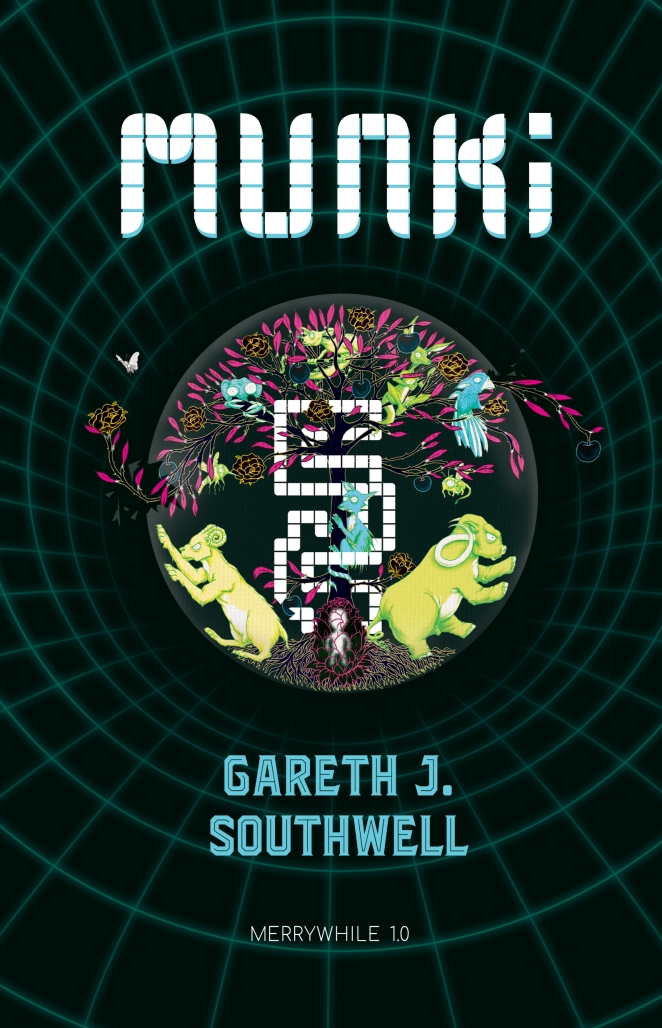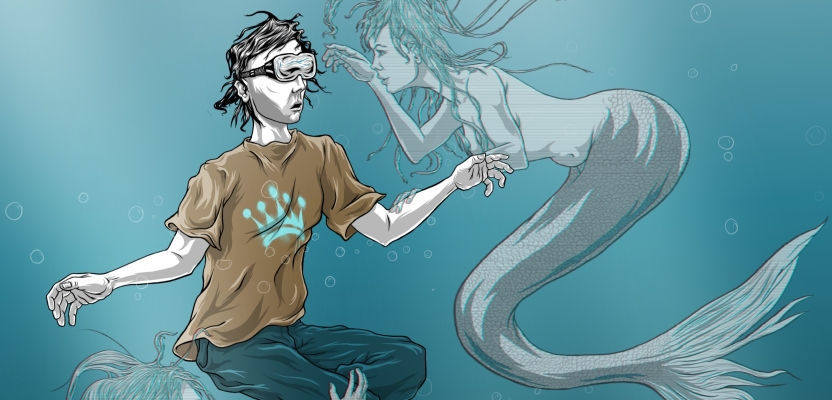How did you get into the industry?
I seem to have developed an eclectic skillset, and I’ve been switching back and fore between images and words my whole adult life. At 18 I chose words, bailing out of a foundation course in Art and Design for a degree in Philosophy and English, which later became a PhD in philosophy.
At some point I also got into teaching philosophy, and discovered that there were very few accessible books to engage students, so I started to write my own. However, I was still drawing, and sent off some caricatures to The Philosophers’ Magazine on spec.
That turned into a regular gig, and when I came to publish my first philosophy books the publisher agreed it was a good fit to use me to provide some illustrations for the cover and inside. And that’s more or less been the story ever since.
Most of my work still revolves around books – I do cover design, illustration and formatting for my own books, as well as offering those services to others.
Where are you based now and who do you work for?

I’m based in Swansea in Wales, UK. I’m freelance, so I work on a self-employed, job-by-job basis. These days, I get a lot of work from self-published authors, and not so much from traditional publishers, which was always a bit hit and miss anyway.
If you weren’t in your current industry, what would you be doing?
Probably in education, teaching or researching.
Can you explain your creative process? What makes it unique?
It used to be more laborious than it is. Once I got a brief, I’d start off with some rough pencil sketches. After some back and fore with the client, I’d refine these as I worked towards the finished artwork, which I would finish with inks, pencils and greyscale Copic markers.
Then, if the final work was to be colour, or would incorporate text or other graphics, I’d scan that and work on it with Photoshop. So, it was a hybrid traditional-digital method. Now, however, I work almost solely digitally, which has sped up my creative process immensely.
I resisted this move for years, thinking that I needed to stand out with a more distinctive style, but once I started getting regular cover work, and the Wacom Cintiq drawing tablet became more affordable, it just became more viable to do the whole process digitally. I’d played around with non-screen tablets before the Cintiq, but it was the ability to draw directly onto the screen that really made the difference.
And it’s so much quicker. Now, I just sketch straight on the screen, then fade the layer and refine the lines, and keep doing that until I’m happy. Also, clients often want tweaks and changes, and having to redraft parts of images with pencil and ink, then scan, was a huge pain in the arse. So, though part of me feels a little sad to make the move, I don’t think I’ll look back.
How would you describe your style?

I’ve done a lot of caricature, some cartoon, and there’s a playfulness and humour that I try to bring to all my work. However, I would say that my preferred style is only slightly exaggerated – just enough to give me the freedom to accentuate things to give the image life.
I also like narrative illustration, images that tell a story, so I guess I’m well suited to book covers/illustration, and I enjoy the challenge of picking the right scene and composition to convey themes, events and characters.
Which individuals do you gain inspiration from? Do you have any heroes in the industry?
My favourite illustrators all have a certain exaggerated style. Early on it was comic book artists like Art Adams and Seth Fisher – I loved the painstaking detail, the monochrome crosshatching.
Later on, it was people like Victo Ngai, James Jean and Yoko Shimizu (not the Hello Kitty one!), so I guess I also like the Japanese aesthetic. I also love Chris Riddell’s work, and I’m amazed and envious at his facility for drawing – his productivity is incredible, and I wish I had that facility, but I’m quite painstaking and slow, though I’m speeding up.
What tips would you give to aspiring creatives looking for work?

This is hard to answer. Develop your style and aim to stand out for being the person who draws like you. This is similar to the advice given to writers to find their own “voice”, and both are hard but necessary journeys.
You can try to ape what’s successful, or another successful artist’s style, but I don’t really see the long-term merit in that. What happens when that style is no longer in vogue? So be you, whoever that ends up being, and become known for that. You’ll come in and out of vogue too, but there’ll be something unique that will draw some people to you.
That said, don’t be afraid to diversify and challenge yourself, try out different styles and personas, different media and processes – finding your style needn’t mean standing still.
What tips would you give to other professionals to get more clients?
This is a harder question than the the last one! Freelance work is precarious, and the last few years have been a real challenge. The threat of lean periods never really goes away, and the temptation is always to take on as much work as possible in case there’s a drought.
A lot of it comes down to luck – being the right person at the right time, just when some art director is looking for (e.g.) a caricature of Nietzsche, and then decides that you’d also be a good fit to illustrate the 6 book series (true story). Diversifying helps – as well as illustration and cover design, I also now offer book formatting and typography.
This means that sometimes I’m stretched pretty thin, but it does mean that you’re a more attractive prospect to current clients if you have more strings to your bow (with self-published authors especially – you’ve done a cover, but they also want someone to format it; but also for traditional clients – I’ve written books for publishers who I’d started off simply doing covers for, and vice versa).
I’m not saying that everyone has to be all singing and dancing, but it certainly doesn’t hurt to widen your skillset. These days, I get a lot of work through Reedsy (a sort of one-stop-shop for publishers and authors for editing, cover design, etc), which I sort of lucked into (they approached me based on a web search and stumbling upon my portfolio).
So, there’s no formula to it, other than working on your style, diversifying, and keeping putting your stuff out there. I still have a mailing list of past and prospective clients, whom I send out to periodically, and which I have built up painstakingly over the years, but I get surprisingly little work through that.
Recently, someone working at a publisher who was an old client – and who is on this newsletter list – approached me for new work. Was it because they’d seem my newsletter updates? No! They’d simply come across the stuff I’d done before for them. And the number of clients who have simply arrived through a random Google images search is depressing.
It’s frustrating when this happens, because it makes it hard to strategise your marketing. So just keep trying – as I say, there is no formula (at least, none I’ve found…).
What kind of tools/kit/software could you not do without?

These days, as I say, it’s my Wacom Cintiq and my iMac. I’ve recently switched to the Affinity suite (Photo and Publisher), because Adobe is just too expensive, and they work great.
What’s your secret to staying inspired and motivated?
To have my own projects. As I’ve said, I’m also a writer, and for my own books I do the covers, illustration, formatting and design. I’ve always found that I need to have my own projects, and this keeps me sane when the client work is perhaps not as interesting or inspiring as it could be.
That said, I love it when you hit it off with a client, and they give you the creative freedom to explore a concept. But I’m happy doing both, really, working for myself and others, and they complement one another.
What’s the work achievement you’re most proud of?

I’ve had fairly sizeable, lucrative projects that have kept the wolf from the door and raised my profile (though never quite as much as you hope…), but I think the best ones are where you come away thinking you’ve done your best work.
My own books, being labours of love (well, certainly not labours of wealth!), have been satisfying because the only person I’ve had to please has been myself. I’ve just set up my own publishing imprint (woodpigpress.com), and I’m looking forward to growing that.
What is the one thing that you would change about the industry?
If the industry is publishing (which it is for me, I suppose), then the main thing would be transparency and fairness around fees and licensing. As a freelancer, you’re continuously second guessing what to charge – is it enough? Too much?
I think a more public conversation about going rates would help – I used to be a member of the Association of Illustrators, who would supply this information, but something happened there a few years ago, and now they aren’t (legally?) allowed to do that, which is a huge shame.
But it’s precarious enough making a living from illustration, without having to worry that you’re being quietly shafted. And now with AI and Dall-E and Mid Journey and so forth, I worry even more that the lives of creatives are about to become even harder.
Any websites, books or resources you would recommend?

Anyone interested in my own work (writing and illustration) can find me here: garethsouthwell.com. My publishing imprint is here: woodpigpress.com. I mentioned Reedsy, and they are always looking out for artists, illustrators and designers, and if you get accepted it can be a welcome addition to the income stream. You can apply here: https://reedsy.com/join-our-community.
Regarding books/websites, anything by Chris Riddell (https://chrisriddellblog.tumblr.com/) or Victo Ngai (https://victo-ngai.com/) is always a joy. If interested in book formatting and interior design, my bible is “Book Typography: A Designer’s Manual”, by Mitchell & Wightman. For more general creativity/inspiration advice, check out The War of Art, by Steven Pressfield.






